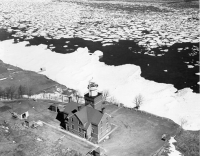The Bell Inn, Thorpe-le-Soken
Dating from the 16th century and originally thought to have been a Guild Hall confiscated by King Henry VIII, the Bell Inn is a Grade I listed building with a reputation of being haunted. The following description was published on 13 October 2014 in the Essex Chronicle within an article by Emily Talbut entitled ‘The 14 most haunted places in Essex to visit this Hallowe’en’. ‘This was once home to notorious bigamist Kitty Canham who is said to haunt the Bell Inn. In 1972, a guest of the pub awoke to find the room’s heavy wardrobe had been moved and the spare bed looked slept in, and many have felt a presence watching them in that same room.
![Torecles [CC BY-SA 3.0 (https://creativecommons.org/licenses/by-sa/3.0)], from Wikimedia Commons](http://www.mysteriousbritain.co.uk/wp/wp-content/uploads/2018/12/1280px-Bell_Inn_Thorpe-le-Soken-300x225.jpg) In 1999, a fire destroyed most of the pub and attached cottage, but Kitty’s painting on the pub’s wall remained undamaged…’
In 1999, a fire destroyed most of the pub and attached cottage, but Kitty’s painting on the pub’s wall remained undamaged…’
The following account from the Bell Inn’s own website describes the story of Catherine (Kitty) Canham (Born 1720 – Died 1752) in more detail. ‘Tales of the ghost of Kitty Canham occupying the Bell Inn go back more than 100 years with the latest spooky stories being told within the last couple of years.
Owners, staff and guests have all felt the presence of a spirit in the pub, while occupiers of neighbouring cottages, which were part of the original Bell pub, have also reported paranormal activity.
Among the stories of being affected by Kitty Canham’s presence, known as the Beautiful Bigamist, is when a wardrobe was moved, a floating four-poster bed, names being called when there was no-one else present and the tightening of bedclothes over a man.
Most of the ghostly goings on have happened in what is known as the Green Room, although other rooms, hallways and the kitchen has had its share on unexplained encounters.
The story of Catharine ‘Kitty Canham begins in Thorpe-le-soken when she married Alexander Gough who was vicar at Michael’s Church, the graveyard of which backs on to the Bell Inn. The Rev Gough was much older than his 20-year-old bride, they lost a baby, and the marriage fell apart. Kitty, bored with life in Thorpe and to get away from her domineering husband, went to London and a far more exciting way of living.
There she met, and married, John Primrose, Lord Delmeny*, who was unaware that she still had a husband in Essex.
He and Kitty then embarked on a fabulous three years exploring the cities, and social life, of Europe.
But while in Verona, ironically the setting for Romeo and Juliet, Kitty fell ill and died of consumption. While on her deathbed she confessed to being still married to Gough but her dying wish was to be buried in Thorpe-le-Soken and St Michael’s churchyard.
Her loving second husband set out to fulfil her wishes and embalmed her body in a casket of brandy and set sail for Harwich. However, a storm blew the ship off course and they ended up going down the River Colne and were met by excise men at Hythe quay.
Suspecting smugglers, a sword was thrust through he casket and her body and the brandy flowed away forcing Lord Dalmeny to confess to his plans.
Kitty’s first husband was sent for and on arrival in Colchester immediately challenged the nobleman to a duel. But once he realised how much Lord Delmeny loved Kitty they became friends and walked together at the funeral at St Michael’s Church.
That should have been that, but in 1800s the churchyard was disturbed during renovations and Kitty’s grave dug up. It was then that the reports of a spirit wandering the hostelry began and have continued ever since.
* John Primrose, born 1725, Lord Dalmeny (Born 1725 – Died 11.8.1755.



Recent Comments